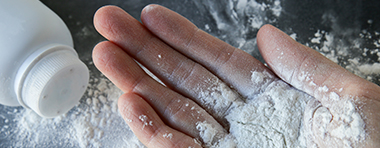Talcum Powder Under Fire Again, Could Still Contain Asbestos
 Talcum powder has been a staple in American homes for generations. Made from talc (a mineral composed magnesium, oxygen, and silicon) talcum powder is used to prevent diaper rash, reduce friction, and keep skin dry. It is also used in cosmetics and other personal care products such as baby powder and adult body and facial powders to absorb moisture, prevent caking, and improve the product’s feel. With so many uses and thousands of products on the market that contain it, one would think that talc is perfectly safe. It’s not.
Talcum powder has been a staple in American homes for generations. Made from talc (a mineral composed magnesium, oxygen, and silicon) talcum powder is used to prevent diaper rash, reduce friction, and keep skin dry. It is also used in cosmetics and other personal care products such as baby powder and adult body and facial powders to absorb moisture, prevent caking, and improve the product’s feel. With so many uses and thousands of products on the market that contain it, one would think that talc is perfectly safe. It’s not.
The world’s largest talcum powder brand, Johnson & Johnson’s Baby Powder, is now at the center of at least 4,800 lawsuits filed by women who claim that the talc used in the famous powder caused their ovarian cancer. Other cases involving everything from women’s face powder and men’s shave powder to even ceramics and pottery have been documented as well, and just this year, a cosmetic made specifically for tweens was pulled from store shelves because the talc used in it tested positive for asbestos.
So how did asbestos find its way into talc? According to the American Cancer Society (ACS), asbestos sometimes appears in natural talc. Now it appears that some of this “natural” talc can still be found in many products American’s use every day. The amounts may seem small to skeptics, but it is a known fact that there is no "safe level" of asbestos exposure. This means, even a “small” amount can cause conditions such as mesothelioma, lung cancer, and asbestosis.
So about those 4,800 lawsuits? Lab, animal, and human studies are mixed, with some suggesting an increased risk of certain cancers from talc use. Further, the ACS says talcum powder could very well cause cancer in the ovaries if the powder particles were to travel through the body to the ovaries. Other studies on cancers such as lung, stomach, and uterine are mixed as well, but the International Agency for Research on Cancer (IARC) of the World Health Organization (WHO) classifies talc that contains asbestos as “carcinogenic to humans.”
Says WHO, “a substance that causes cancer or helps cancer grow is called a carcinogen.” Research in this area is ongoing.
If you are concerned about asbestos-containing talcum powder, the ACS suggests avoiding it or limiting your use of products that contain it.
Sources
Hsu, Tiffany. "Risk on All Sides as 4,800 Women Sue Over Johnson’s Baby Powder and Cancer." The New York Times. The New York Times Company, 28 Sept. 2017. Web. 06 Oct. 2017.
"Pottery Artisan’s Fatal Mesothelioma Caused by Industrial Talc, Widow Awarded $3.35 Million." N.p., 11 Nov. 2006. Web. 16 Oct. 2017.
"Talcum Powder and Cancer." American Cancer Society. American Cancer Society, Inc., 2017. Web. 06 Oct. 2017.



